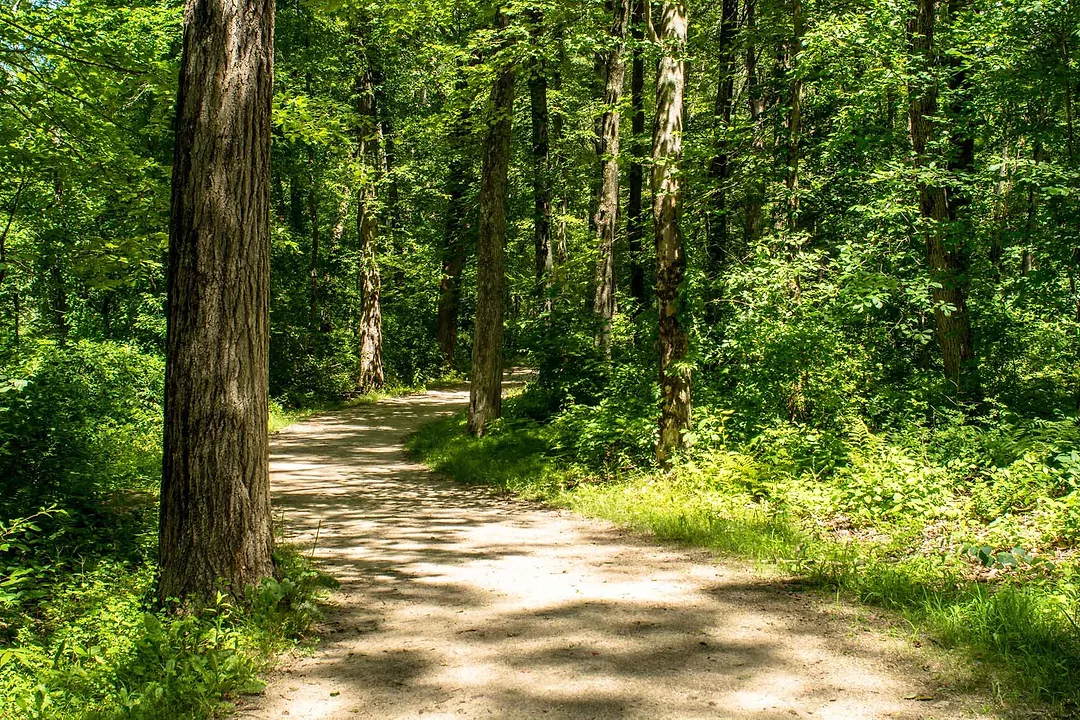As the warm weather arrives, nature puts on a stunning display of lush green meadows, brilliant flowers, and trees bursting with life. Animals, birds, fish, amphibians, reptiles, and a plethora of bugs and insects can be seen and heard as they go about their daily lives – bringing a smile to young and old alike. Spending time in nature is both grounding and humbling – and many people find themselves feeling more calm and just plain happier after a stroll by the river or a walk through the forest. It is truly amazing how many special places there are to enjoy these experiences in and around Concord. To help you get started, we have put together a quick guide and a QR Code link to maps of some of our favorite spots. Just hover the camera of your smartphone over the code and a link will pop up – click it and you will see a map of the area to guide your walk. From history to literature, to the wild and scenic – we hope you will find inspiration in this article to get outside and explore Concord’s stunning nature!

Battle Road
| ©istockphoto/sphraner

The Battle Road
The Minute Man National Historical Park includes a 4.9-mile trail that runs the length of the battle road where 700 British regulars marched into Concord in search of weapons and along which intense fighting took place as they returned to Boston on April 19, 1775. Beginning at Meriam’s Corner and ending at Fiske Hill, the trail runs directly past – or very near – all of the historical sites in the park, including several beautifully preserved ‘witness houses’ where citizens experienced that harrowing day firsthand. Hiking or biking is the only way to see everything, although there are parking lots at all the major sites which provide inroads to the key attractions. If you begin your walk at Fiske Hill, park at the lot at Old Massachusetts Avenue and walk across the road to the Ebenezer Fiske House Site to find the trailhead. From there, markers long the trail indicate the distance remaining from one end to the other.
While this is one of the longer hikes featured in this guide, it is a very easy stroll and a pleasant one as well. Much of the trail is a wide, gravel path. There are some minor hills, but wheelchairs can still travel along this trail with some assistance, and most hikers will find this to be an easy walk. There are shade trees along many sections (though not all) of the path as well, making this a nice choice on a warm summer day. During the busy summer season, you will often find park rangers or historic reenactors along the route – offering educational insights into our nation’s history. Remember that this is an out-and-back trail meaning that if you walk the five miles, you will need to walk the full five back to your vehicle. If you are walking with a friend, try parking one car at one end of the trail and then starting at the other end. You can also chain up a bike at one end of the park and then drive/park to the other end to begin your tour through America’s history.

Emerson-Thoreau Ramble
| ©istockphoto/Kirkikis

Emerson-Thoreau Ramble
Literary fans will appreciate this unique opportunity to combine a delightful stroll outdoors with the chance to see both the home of Ralph Waldo Emerson and the site of Henry David Thoreau’s cabin on Walden Pond. This 1.7-mile stroll begins at the Ralph Waldo Emerson house, just across the street from the Concord Museum, and culminates at the site of Thoreau’s cabin. Other points of interest include the Heywood Meadow, a stroll through the wet, low-lying area along Mill Brook, and a view of the “Ice House,” where various companies since 1906 supplied block ice until refrigeration became commonly available. Connections to other popular trails are accessible as well. With a walking time of 40 to 60 minutes each way, hikers are wise to bring water (and bug spray) for this lovely amble through history, literature, and nature.

White Pond
| ©Christine Gerzon

White Pond
Formed by the same glacier responsible for Walden Pond, this 39.68-acre kettle pond is adjacent to the White Pond Reservation in West Concord. The terrain here consists of glacial till with steep banks down to the water. Please stay on the marked trails to avoid erosion of these sandy soils, which are populated with pine, oak, hemlock, and birch trees. Nature lovers will enjoy the plethora of wildlife to be found here. Mammals include deer, coyote, fox, raccoon, red and grey squirrels, chipmunk, and skunk. Painted turtles, frogs, salamanders, tree frogs, and water snakes are among the reptiles and amphibians to be found. And birds are abundant – from herons, ducks, and kingfishers to the less commonly spotted wood ducks, osprey, and even bald eagle.
While Henry David Thoreau is almost synonymous with Walden Pond, he was very familiar with – and greatly admired - White Pond as well. He once wrote, “…perhaps the most attractive, if not the most beautiful of all our lakes, the gem of the woods, is White Pond.” He would even collect sand from the eastern side of the pond to use as sandpaper for his family’s pencil business. This area remains a true gem, with Concord Conservation Land and Town land providing more than 70 acres of well-developed hiking trails for all to enjoy.
 Walden Pond
Walden Pond
One of the most iconic nature walks in the Concord area, Walden Pond provides an enchanting combination of ecology, literature, and history. Walden ‘pond’ is actually a 102-foot-deep kettle hole – formed by a melting glacier more than 12,000 years ago. It is Massachusetts’ deepest natural body of fresh water. There are several walking trails around Walden Pond, including side trails that will bring you to the site of the cabin where Henry David Thoreau famously spent two years, two months, and two days living simply in nature and discovering what it could teach him. In addition to several trail options, visitors can enjoy a refreshing swim or a (non-motorized) boating adventure. The Walden Pond State Reservation is an extremely popular destination in the warm summer months. To protect this precious natural resource, the park closes to the public once it reaches a set capacity, so please check the website or Twitter feed for updates before heading out for your next adventure here.

Yellow Warbler
| ©istock/Ken Canning

Brewster’s Woods
Mass Audubon Brewster’s Woods Wildlife Sanctuary is a 130-acre property along the banks of the Concord River. This historic site was formerly part of the country homestead of William Brewster, an early leader in American ornithology and the first President of Mass Audubon. Nearly two miles of trails lead you through the shade of mature woodlands into open fields and along the edges of the Concord River floodplain. A large riverside marsh was apparently created by William Brewster to provide habitat for ducks and other water birds. The trails are great pathways for birding, wildlife photography, and sketching. Limited parking for four vehicles can be accessed at the end of Balls Hill Road off Monument Street.

West Concord Park
For a brisk, 25-minute walk, head to this conservation area in West Concord to enjoy a 21-acre haven of woodland and marsh in this mixed commercial and high-density residential area. This pretty park was revitalized in 2014 when trails were cleared and blazed, invasive plants removed, and new access developed through Warner Woods from Laws Brook Road. The topography of this trail varies greatly, from the high ground of Pigeon Hill to the large bogs 60 feet below. A small parking lot and an information kiosk can be found on Conant Street.

Eastern Kingbird
| ©istock/maiakphotography

Great Meadows Wildlife Refuge
Great Meadows National Wildlife Refuge is roughly 85% composed of valuable freshwater wetlands alongside the Sudbury and Concord Rivers. This important refuge provides habitat for native fish and wildlife – especially migratory birds. The refuge’s wetlands, fields, and woods provide a home for many species, including vast avian groups, semi-aquatic mammals like beaver and muskrats, white-tailed deer, small mammals, insects, amphibians, and reptiles. Great Meadows has the largest distinct populations of threatened Blanding’s turtle in the northeast. The wetlands and adjacent forests and fields provide great habitat for all species, including pollinating insects such as monarch butterflies, other reptiles such as the northern water snake, raptors, turkeys, coyotes, and woodchucks.
The Sudbury unit includes tranquil trails around wetlands and through woodlands and features a non-motorized boat launch on the Sudbury River. The Concord unit (with a trail map at this QR code) has excellent birding, and noted ornithologists consider this to be one of the best inland birding areas in Massachusetts – with a recorded bird list of more than 220 species! The Concord unit has a wildlife observational tower, observational platform, and direct access to the Concord River. Please note: there is an entrance fee for the Concord Unit. Absolutely no dogs are allowed at this protected site for birds.

Canada Goose and Goslings
| ©istock/Ken Canning

October Farm
With 80 acres of ample water and topographic and vegetative diversity, this land is outstanding wildlife habitat. Four rare species have been found in and near the area, as well as three vernal pools. Wood frogs, spring peepers, and blue-spotted salamanders breed in the ponds and vernal pools; the blue-spotted salamander is a state-listed species of special concern. A wide variety of waterfowl, shorebirds, birds of prey, and songbirds abound here during the summer and the spring and fall migrations.
Important in its own right as a wildlife habitat, the property is also important as part of a much larger whole. Along the opposite bank of the Concord River, extending for several miles upstream and downstream, is the Great Meadows National Wildlife Refuge. The October Farm Riverfront is also a critical ecological link with the more than 1,600-acre Estabrook Woods to the west. As a keystone in the network of open space, the landscape provides rich and intact larger habitats in the area and allows wildlife movement between them for breeding, migratory, and overwintering habitats for a variety of wildlife species. Trails are available on Town Conservation land. Please park only in the designated area and not on Balls Hill Road.

Lots of creatures great and small enjoy the beautiful warm weather this time of year. Be aware of ticks and bring along insect repellant and appropriate clothing to ward off mosquitos. Bring water and a light snack with you on longer walks, and please observe leash laws for your canine companions (and, of course, you’re going to pick up after them, yes?). Concord’s access to these beautiful conservation lands depends on everyone being a good neighbor. Please park only in designated areas, carry out anything you bring into the trail areas, and please respect private property. Looking for more? The Concord Visitor Center has trail maps and also sells a collection of 14 area guides/maps in the book Ecology Along Concord Trails by Richard T. T. Forman, Delia R. J. Kaye, and Robert White.
With special thanks to the Town of Concord’s Natural Resources Division, Mass Audubon, the Minute Man National Historical Park, and Preserve White Pond for their generous time and contributions. Please visit their websites and support their important work.



